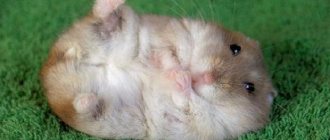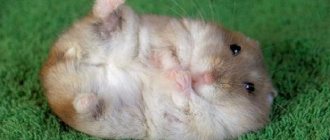Let's start with a couple of lines of encyclopedic information. Do you want to know where your animal comes from and what it is like? And then we’ll immediately talk about caring for Syrian hamsters.
One of the cutest pets.
Syrian hamsters (aka royal, golden, golden) were first mentioned in the 18th century, but a scientific description appeared only in 1836. They were discovered near Aleppo (Syria), which is why they got their name. After this, the rodent was considered extinct for a long time, because The stubborn Syrian hamster did not show itself to the researchers.
The cunning Syrian, foreseeing the future of toys for children and laboratory “consumables” (joke), migrated to the territories of modern Israel, Turkey, Iran, the Balkans, where he still lives safely.
The Syrian hamster hid for almost 100 years, and in 1930, an Israeli zoologist discovered a female with 12 hamsters. Only 4 survived, but this was enough for the rodent to become one of the most popular pets in our time.
Origin of Syrian hamsters
The species was first described by a 19th century zoologist. George Robert Waterhouse. In 1839, the scientist worked on compiling catalogs of mammals and birds brought by Charles Darwin from his trip around the world. Among the specimens was a Syrian hamster. Then, for a long time, this rodent was not encountered by natural scientists during their expeditions. It was considered extinct.
The Syrian hamster is also called the Central Asian hamster.
Only in 1930, near the Syrian city of Aleppo, another representative of this breed was found. Israeli biologist Israel Aharoni managed to find a pregnant female, who soon gave birth to 11 cubs. Within a year, Professor Aharoni had 150 rodents. After a couple of years, there were so many animals that he was able to send them to his colleagues in America and Europe, where they became widespread.
Description of the breed
The anatomy of the golden hamster allows it to carry large volumes of food that other rodents of similar size cannot carry at once. This is possible thanks to the cheek pouches. When filled, they double the volume of the head.
The animal is distinguished by its overall stockiness and short limbs. The front paws have 4 toes, and the hind paws have 5.
Habitat
Natural habitat - Central and South Asian steppes, Persian Gulf countries. There are representatives of the breed in Africa, Europe and America. Animals often choose to live in cultivated areas, parks and vegetable gardens - rich sources of food. Now wild individuals are rare. These are either pets or laboratory specimens.
Syrian hamsters are considered picky animals. They can adapt to living in almost any conditions.
Coat color and length
Syrian hamsters come in short-haired and long-haired varieties. Do not cross these species, because... the cub may become the owner of wool that does not fit into the breed standards.
The following color options are available:
- golden;
- black;
- white;
- yellow-brown;
- cream;
- dark grey;
- pearl;
- Agouti is a zoned coat color.
The most common shades are cream and golden. Coat color can change throughout the animal's life. Basically it becomes darker.
Thanks to the variety of types of Syrian hamsters, everyone can choose a pet to suit their taste.
Length and weight
Compared to their other relatives, Syrian rodents are quite large: body length is 13 cm or more, weight - 125-150 g. Females are larger than males.
Scent glands
The presence of scent, or marker, glands is a distinctive feature of golden hamsters. The glands secrete a special secretion that rodents use to mark their territory. Visually, these are 2 symmetrical black spots on the sides of the animal. The spots can be barely visible, or they can stand out strongly, having a rough surface and more like warts. Males have more pronounced glands. The rodent can rub its sides against the cage to leave a secret there and claim its territory.
A change in the appearance of the marker glands is a reason to consult a veterinarian. This may be a consequence of the development of inflammatory processes or cancer.
Character and lifestyle
The Syrian hamster, like many of its relatives, is more active at night. This is due to the peculiarities of the life of rodents in the wild, where they are forced to hide from predators. Twilight is a natural shelter. The animal was domesticated relatively recently, so its genetics and lifestyle did not have time to adapt to the new rhythm.
In their natural habitat, rodents dig tunnels and strive to create a home and pantry for themselves - a place to store supplies. If resources allow, the animal is capable of making supplies whose weight will exceed its own 100 times.
Under natural conditions, Syrian hamsters live in shallow burrows and are active at night.
The main behavioral characteristic of animals is activity. They are curious and friendly, but can become aggressive when frightened. To avoid this, pick up your pet carefully, without sudden movements. Give him time to get used to your smell and offer him a treat. This way the hamster will be more willing to make contact.
Rodents have intelligence, are able to recognize their owner and respond to a name.
Lifespan
On average, these pets live 2-3 years. Life expectancy directly depends on the conditions of detention and proper care.
Owner reviews
Syrian hamsters are characterized by having a sociable and friendly character, so they prefer to be in constant contact with their owner.
Such a pet requires constant care, as well as unobtrusive love, since excessive attention can lead the animal to stress, and subsequently to the manifestation of a number of ailments that are difficult to deal with.
Important point! According to many experienced owners, it is enough for Syrian hamsters if you handle them no more than 3 times a day, for 15 minutes, no more.
These animals, despite their mobility and curiosity, are mainly active in the dark. It follows from this that it is better to choose evening hours to communicate with your pet.
Syrian hamsters, due to their ease of care and maintenance, are very popular. They are typically one of the first pets children encounter. Since this animal does not require special care and maintenance, and its character is quite friendly and flexible, all family members and especially children quickly become attached to this pet.
Selection and arrangement of the cage
In the wild, animals are active and mobile. A properly selected cage will allow the animal to live in its usual rhythm and will be the key to its good health.
Requirements
The more spacious the cage and the more tiers it has, the better. Hamsters love stairs and passages. The rods should be metal: they let in a lot of light and air, and it is impossible to chew through them. It is better to choose a plastic tray: it is easy to care for and does not absorb odors. A mandatory element of the home is a special house where the hamster will hide and stock up.
Syrian hamsters are relatively large in size, so a small cage is not suitable for keeping such a pet.
Drinker and food bowls
When choosing a bowl for food, it is better to give preference to a ceramic one, because... it is more stable compared to plastic. Place it on one of the upper tiers - this will protect the container from dust and debris.
Ceramic dishes can also be used for water, which should always be in the cage. The sides should not be high so that the hamster does not have to stretch. Sometimes inexperienced breeders have concerns that the animal may accidentally choke when left unattended. But this option of supplying water is considered more natural and convenient for the animal. If you choose the right bowl and pour no more than 100 ml of liquid, no harm will happen.
There are special sippy cups in the form of bottles. They are attached to the cell walls using suction cups or hooks. The rodent receives water through a straw. The water in such a drinking bowl is protected from dust and debris. But the bottle requires careful care. If hygiene is poor, mold will quickly form inside.
Sports area
Sports activity is an important factor influencing the lifespan of a Syrian hamster. A running wheel should be a must-have exercise machine. It is better to choose a model without crossbars and with a small distance between the rods so that the animal’s paws do not fall through. Securely attach the exercise machine to the wall of the cage or install it inside using a special stand.
If space allows, add mazes and obstacle courses. This will diversify your pet’s leisure time and provide additional physical activity.
Filler
The bottom of the cage must be sprinkled with a layer of filler. It is needed to neutralize odor and absorb pet waste. Pressed sawdust is well suited for these purposes. They will not cause harm if the animal decides to chew them a little or use them to decorate their home.
Good bedding for a hamster's cage is no less important than quality food.
Cleaning
You need to keep order in your rodent’s home every day: change water and food, spot remove dirty litter, throw away spoiled food. Wash the cage once a week and completely change all the litter. It is recommended to use gentle cleaning agents without a strong odor. To remove heavy stains, use a weak solution of vinegar.
Supplies in the house should be periodically reviewed, but if the food has not spoiled, do not throw it away.
Additional accessories
When you equip the cage with everything necessary for a comfortable life for your pet, take a closer look at the accessories. They won't let your pet get bored. There is a wide choice: hammocks, plastic and plush tunnels, slides, cotton wool nests, rings and even special play complexes.
Diseases.
A sick hamster can be easily identified by its habits. He starts hiding and sleeps a lot. The coat becomes unkempt and disheveled. The animal is lethargic, does not play, does not eat or drink, loses weight, its eyes are closed. The main reasons for poor condition:
- Unfavourable conditions
- Poor nutrition
- Stress
Hamster diseases can be divided into those that are contagious to humans and those that are not. The first group includes:
- Infections
- Parasites
- Fungi
The source of infection can be a person, an animal, food, or bedding.
The most common diseases are:
- Lymphocytic choriomeningitis is transmitted from other animals. An adult hamster suffers from it asymptomatically, while young animals suffer from conjunctivitis and damage to the respiratory system. Therefore, it is often recommended not to purchase a hamster under three months old.
- Intestinal diseases accompanied by diarrhea. In this case, the animal dies from dehydration. To save him, a course of antibiotics and more fluids are needed. Prevention measures: regular cage cleaning.
- The herpes and influenza virus is characterized by a runny nose and inflammation of the eyes. The animal can recover on its own in 3 days, with good care.
- Pneumonia is severe, with fever and wheezing. The animal is pale and inactive. As a rule, the disease leads to death.
- Demodicosis is accompanied by damage to the subcutaneous tissue by mites. If the hamster is peeling and itching, then this is not an allergy. Fortunately, the disease is treatable. An experienced veterinarian can easily save your pet.
- Intestinal parasites. It is difficult to judge an infection from an animal’s behavior. If your hamster eats a lot and is losing weight, then you should give him the drug “Shustrik” to drink. It will even be useful for preventive purposes.
- Conjunctivitis is not a contagious disease. If your animal's eyes stick together and run, wash them with furatsilin solution and drop in sodium sulfacyl (Albucid) or chloramphenicol.
If a pet is bitten, then a rabies injection is not given, but the wound must be properly treated. It is worth noting that diarrhea can occur not only due to infection. Unbalanced nutrition, too juicy food also leads to digestive disorders.
Cases of injury while walking around the house cannot be ruled out. If the heat and light regime is not observed, heat stroke or hypothermia may occur. Always keep a disinfectant in your first aid kit, especially if you have two pets in a cage.
Syrian hamster nutrition
The activity, immunity and lifespan of a rodent largely depend on its diet. To create a balanced menu, you need to know the feeding behavior of an animal in the wild.
Mode
The hamster is a nocturnal animal, its activity time falls at dusk.
Divide the daily amount of food into 2 meals. In the evening, the portion of food should be larger than in the morning.
Diet
In their natural habitat, the diet of rodents includes the following components:
- cereal grains;
- greens, fruits and vegetables;
- insects and worms, i.e. protein.
You need to feed your pet in a balanced manner at home.
The Syrian hamster's diet should be well balanced.
The hamster's diet consists of cereals:
- wheat:
- rye;
- oats;
- corn;
- millet.
Add peanuts, nuts, dried peas, sunflower seeds, watermelon and melon to your menu.
You can buy ready-made cereal mixture. If you prepare the food yourself, keep in mind that peanuts and nuts are high in fat. Their content in the total mass of the finished product should not exceed 10%.
Feed your rodent plant foods daily.
It can be greens, clover, plantain, lettuce, parsley, dill. It is better not to include wormwood and dandelion (especially its stems) in the animal’s diet.
Fresh vegetables allowed:
- carrot;
- cucumber;
- zucchini;
- radish;
- Bell pepper.
The following fruits are suitable as a treat:
- apples;
- bananas;
- pears;
- peaches.
It is not worth giving them often, because... they contain a lot of sugar. For the same reason, dried fruits should be excluded from the rodent’s diet. But you can treat your hamster with berries every day.
On average, a rodent should receive about 30 g of cereals, 20 g of vegetables and herbs every day. Additionally, you can offer your pet 1-2 nuts and a few pieces of fruit.
Several times a week the animal should receive 5 g of protein food.
Low-fat cottage cheese, boiled eggs and chicken are suitable. In pet stores you can purchase insects and worms specifically designed for feeding.
Toys for grinding teeth
Rodents' teeth constantly grow. Give your pet a tree branch to grind them down. Recommended are beech, apple, birch, oak, cherry, pear, birch, and willow. Coniferous tree branches should not be given.
The mineral ring must be kept in the Syrian hamster's cage at all times.
There are special mineral stones for rodents on sale. They not only help to grind teeth, but also add useful substances to the pet’s diet: calcium, phosphorus, iron, selenium.
Delicacy
A hamster's diet may seem monotonous and boring. after all, it is dominated by ordinary grains and vegetable crops. In addition to the main menu, the Syrian hamster can be pampered with treats that he can consume without any harm to his own health:
- fruit chips;
- dried fruits (raisins, dried apricots);
- popcorn (unsalted and without butter);
- pink petals.
Stores that sell pet supplies sell special tasty treats for hamsters:
- grain sticks, balls, houses, etc.;
- fruit and nut mixtures;
- tartlets with filling;
- a cookie treat (not to be confused with homemade cookies).
You can prepare delicious treats with your own hands:
- Roll banana pulp, raisins and oatmeal into balls. You can add grated carrots and apples.
- Add the usual grain mixture to the beaten egg white, mix and form small cakes. Bake at +30...+60 °C in the oven until hardened.
- Prepare a salad from fresh herbs (clover, etc.) and finely chopped walnuts.
- String tasty pieces (vegetables, fruits, etc.) onto a toothpick.
Syrian hamsters will appreciate and with great pleasure treat themselves to grain sprouted into grass.
Rules for caring for a Syrian hamster
Syrian hamsters are easy to care for. For a pet to live comfortably, it is necessary to keep the cage clean and provide regular and balanced nutrition.
Walks and games
If the animal's cage is equipped with everything necessary, then it does not require additional walks.
If you want to let your pet roam around the apartment, purchase a special ball. The hamster will not be able to escape from it and will always be in sight.
What not to do
You should not let your hamster out on the street: in the grass you will quickly lose sight of him.
Protect the animal from falling from heights. The bones of his skeleton are fragile, and any fall can end sadly, even fatally. Be careful when handling your pet. Don't leave him outside his cage unattended.
Health problems
Owners of Syrian hamsters should carefully monitor the behavior of their animals. Most often, “Syrians” suffer from stressful situations that can arise due to disruption of the daily routine, the appearance of another animal in the cage, moving the house, and the like. It is worth contacting a veterinarian if your animal exhibits symptoms such as:
- wet fur;
- aggressive behavior;
- fleas;
- bad stool;
- hair loss;
- hard breath.
Reproduction of Syrian hamsters
Rodents reach sexual maturity at 6 weeks. But for breeding it is better to choose individuals no younger than 4-6 and no older than 18 months. Avoid crossing blood relatives, because this can lead to genetic mutations and deformities in the offspring.
After birth, you should not touch the cubs with your hands, otherwise the female is able to eat all her offspring if she senses the presence of foreign odors.
Pregnancy period
A pregnant female should be fed protein foods and kept separate from other hamsters, because she can be aggressive. Gestation lasts about 16 days.
Offspring
From 8 to 12 individuals are born in a litter. The lactation period is 20 days. If you do not provide the female with adequate nutrition during pregnancy and feeding her offspring, she may eat her cubs.
Buying a pet
When choosing an animal, be sure to pay attention to its behavior and appearance.
Number of pets
The animal carefully guards its territory and does not tolerate the presence of strangers. When purchasing several rodents, each will need a personal cage.
Where to buy, price
The cost of a pet will depend on its color, place of purchase and region of your residence.
Where can you buy a hamster and how much will it cost?
- At the poultry market or from hand. The cheapest option. Price 100-300 rub. If you're lucky, an unwanted or unexpected offspring can be given away for free into good hands.
- Purchase at a pet store. Price 300-500 rub.
- Purchase from a nursery. Price 400-1000 rub. This is the most expensive option, but you will get a pet with a pedigree.
In addition to the cost of purchasing a pet, you will also have to spend money on a finished cage with everything you need, food and filler. This is still from 3500 rubles.
What to look for
Be sure to pay attention to the following indicators:
- fatness;
- active behavior;
- excessive aggressiveness (perhaps he has such a character);
- the coat is shiny and thick;
- absence of discharge from the eyes and nose;
- the area around the anus is dry;
- age (2-3 months is best, a young animal is easier to tame).
How to find out age and gender
Young hamsters are very active, curious and love to eat. Old people may even sacrifice food in favor of sleep. Juveniles can be distinguished by the thin light fur on their ears. Dull eyes indicate old age. This may also be an indicator of the disease.
Until 5 days the hamster has practically no fur. By 15 days, wool does not grow everywhere. Young fur has a bright color. If there are bald patches on it, then the animal is up to 1 month old. By 3 months, the animal’s weight will be no more than 40 g. The weight of an adult is 110-120 g.
To determine the sex of a hamster, you need to take it by the scruff of the neck and lift it. He will stretch his body and spread his legs to the sides. The difference between a female and a male is expressed in the distance from the anus to the genitals. In females it is about 3 mm, and in males it is 10-15 mm.
How to name
There are virtually no restrictions on choosing your pet's name. It can be selected according to the following principles.
- coat color (Ryzhik, Snowball, Black, Gray, Marshmallow, Sunny), you can refer to dictionaries not only of Russian and English (Schwartz, Bianka);
- character (Sonya, Shusha, Fugitive);
- physique and appearance (Donut, Fluffy);
- in honor of their idols (Angelina, Lolita, Johnny);
- according to the hamster’s taste preferences (Carrot, Potato);
- nickname in human style (Senya, Filya, Timka).
Interesting facts and myths
In ancient times, hamsters were associated with evil spirits and witchcraft.
A hamster is not a toy, but a pet that requires attention and proper care.
Now they are shrouded in completely different myths:
- These are living toys. A hamster should not be considered a toy. It requires care and respect. The animal can be tamed, but it will take effort.
- It is impossible to get rid of the cage smell. If the filler is replaced in a timely manner, there will be no unpleasant odors. The hamster is clean.
- The pet does not need water. This is wrong. Without drinking water, the animal will die.
Interesting Facts:
- The animals are used in laboratory research. They are susceptible to human viruses and have a similar tooth structure to ours.
- Matriarchy reigns among rodents of this species. The female is larger than the male and decides who will be the father of the offspring.
- In England there is a club of golden hamster lovers, which publishes its own newspaper and regularly selects a hamster of the month.
How to avoid stress?
Why avoid it at all? When a pet is stressed, its behavior changes unpredictably. He may stop eating, may behave aggressively or, conversely, indifferently. Caring for a Syrian under stress becomes very difficult.
We have already listed the main stress factors, let’s summarize them:
- Noise, especially loud
- Daylight
- Water treatments
- Other hamsters and animals
Hamsters are solitary animals; they unite only during mating. Remember this, and do not try to “make friends” of the Syrian with other hamsters and other pets.
It is also worth gradually accustoming the golden handsome man to your hands. The Syrian is the most peaceful type of hamster, but even among them there are quarrelsome characters. There is no point in rushing things and expecting mutual love from the first days.
Read more about taming and other training on our website.
That's how stressed I am... Don't hurt the rodent!











